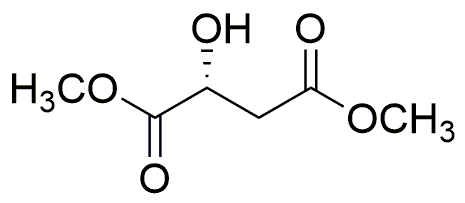Dimethyl (R)-(+)-malate is widely utilized in research focused on:
- Flavor and Fragrance Industry: This compound is used as a flavoring agent in food products, providing a fruity taste that enhances the overall sensory experience.
- Pharmaceutical Applications: It serves as an intermediate in the synthesis of various pharmaceuticals, contributing to the development of new medications with improved efficacy.
- Biochemical Research: Researchers employ it in metabolic studies to understand its role in energy production and its effects on cellular processes.
- Cosmetic Formulations: The compound is incorporated into skincare products for its moisturizing properties, helping to improve skin texture and hydration.
- Biodegradable Plastics: It is explored as a building block for creating eco-friendly polymers, promoting sustainability in the materials industry.
Informations générales
Propriétés
Sécurité et réglementation
Applications
Dimethyl (R)-(+)-malate is widely utilized in research focused on:
- Flavor and Fragrance Industry: This compound is used as a flavoring agent in food products, providing a fruity taste that enhances the overall sensory experience.
- Pharmaceutical Applications: It serves as an intermediate in the synthesis of various pharmaceuticals, contributing to the development of new medications with improved efficacy.
- Biochemical Research: Researchers employ it in metabolic studies to understand its role in energy production and its effects on cellular processes.
- Cosmetic Formulations: The compound is incorporated into skincare products for its moisturizing properties, helping to improve skin texture and hydration.
- Biodegradable Plastics: It is explored as a building block for creating eco-friendly polymers, promoting sustainability in the materials industry.
Documents
Fiches de données de sécurité (FDS)
La FDS fournit des informations de sécurité complètes sur la manipulation, le stockage et l’élimination du produit.
Spécifications du produit (PS)
Le PS fournit une description complète des propriétés du produit, notamment sa composition chimique, son état physique, sa pureté et les exigences de stockage. Il détaille également les plages de qualité acceptables et les applications prévues du produit.
Certificats d'analyse (COA)
Recherchez des certificats d'analyse (COA) en saisissant le numéro de lot du produit. Les numéros de lot et de lot se trouvent sur l'étiquette d'un produit, après les mots « Lot » ou « Lot de fabrication ».
Numéro de catalogue
Numéro de lot/série
Certificats d'origine (COO)
Ce certificat d'exploitation confirme le pays dans lequel le produit a été fabriqué, et détaille également les matériaux et composants utilisés et s'il est issu de sources naturelles, synthétiques ou autres sources spécifiques. Ce certificat peut être requis pour les douanes, le commerce et la conformité réglementaire.
Numéro de catalogue
Numéro de lot/série
Fiches de données de sécurité (FDS)
La FDS fournit des informations de sécurité complètes sur la manipulation, le stockage et l’élimination du produit.
DownloadSpécifications du produit (PS)
Le PS fournit une description complète des propriétés du produit, notamment sa composition chimique, son état physique, sa pureté et les exigences de stockage. Il détaille également les plages de qualité acceptables et les applications prévues du produit.
DownloadCertificats d'analyse (COA)
Recherchez des certificats d'analyse (COA) en saisissant le numéro de lot du produit. Les numéros de lot et de lot se trouvent sur l'étiquette d'un produit, après les mots « Lot » ou « Lot de fabrication ».
Numéro de catalogue
Numéro de lot/série
Certificats d'origine (COO)
Ce certificat d'exploitation confirme le pays dans lequel le produit a été fabriqué, et détaille également les matériaux et composants utilisés et s'il est issu de sources naturelles, synthétiques ou autres sources spécifiques. Ce certificat peut être requis pour les douanes, le commerce et la conformité réglementaire.

